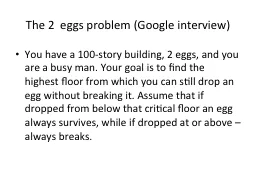PPT-The 2 eggs problem (Google interview)
Author : pasty-toler | Published Date : 2019-06-26
You have a 100story building 2 eggs and you are a busy man Your goal is to find the highest floor from which you can still drop an egg without breaking it Assume
Presentation Embed Code
Download Presentation
Download Presentation The PPT/PDF document "The 2 eggs problem (Google interview)" is the property of its rightful owner. Permission is granted to download and print the materials on this website for personal, non-commercial use only, and to display it on your personal computer provided you do not modify the materials and that you retain all copyright notices contained in the materials. By downloading content from our website, you accept the terms of this agreement.
The 2 eggs problem (Google interview): Transcript
Download Rules Of Document
"The 2 eggs problem (Google interview)"The content belongs to its owner. You may download and print it for personal use, without modification, and keep all copyright notices. By downloading, you agree to these terms.
Related Documents














